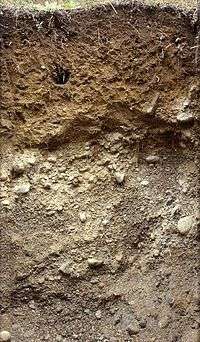Inceptisol
Inceptisols are a soil order in USDA soil taxonomy. They form quickly through alteration of parent material. They are more developed than Entisols.[1] They have no accumulation of clays, iron oxide, aluminium oxide or organic matter. They have an ochric or umbric horizon and a cambic subsurface horizon.
| Inceptisol | |
|---|---|
 Inceptisol profile | |
| Used in | USDA soil taxonomy |
In the World Reference Base for Soil Resources (WRB), most Inceptisols are Cambisols or Umbrisols. Some may be Nitisols. Many Aquepts belong to Gleysols and Stagnosols.[2]
Suborders
- Aquepts – with a water table close to the surface
- Gelepts – in very cold climates
- Cryepts – in cold climates
- Udepts – in humid climates
- Ustepts – in semiarid and sub-humid climates'
- Xerepts – in areas with very dry summers and moist winters
gollark: ···
gollark: That seems like a very lacking explanation.
gollark: Guaranteed Icosahedra.
gollark: Ah, so blackmail.
gollark: Cognitohazards which gave the impression of paying tuition.
References
- "Inceptisols" (PDF). USDA-NRCS. Retrieved 2014-11-06.
- "Inceptisols". University of Florida. Archived from the original on September 18, 2004. Retrieved 2006-05-14.
- "Inceptisols". University of Idaho. Archived from the original on 2006-09-01. Retrieved 2006-05-14.
- "Inceptisols". Michigan State University.
- IUSS Working Group WRB (2015). "World Reference Base for Soil Resources 2014, Update 2015" (PDF). World Soil Resources Reports 106, FAO, Rome.
This article is issued from Wikipedia. The text is licensed under Creative Commons - Attribution - Sharealike. Additional terms may apply for the media files.